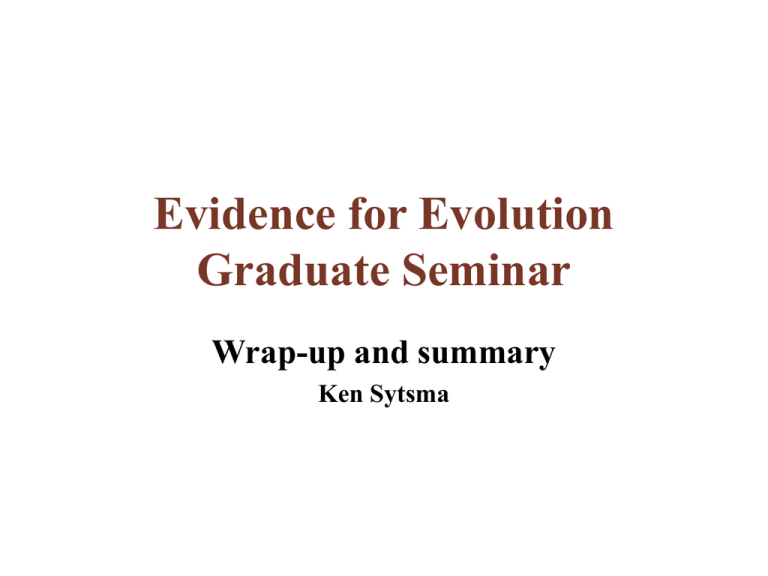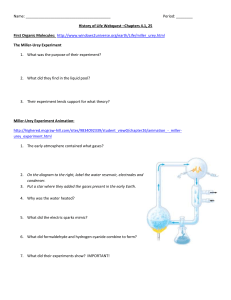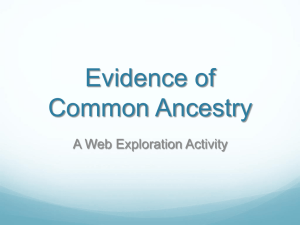Summary of course
advertisement

Evidence for Evolution Graduate Seminar Wrap-up and summary Ken Sytsma The three main claims of Darwinian evolution • Living species are related by common ancestry • Change through time occurs at the population not the organism level • The main cause of adaptive evolution is natural selection (and related mechanisms) The main cause of adaptive evolution is natural selection • Claim 1: Natural selection happens – vs. Natural selection does not/cannot happen • Claim 2: Natural selection is sufficient to explain even the most complex traits of living organisms – vs. natural selection is not sufficient Evidence for common ancestry (against separate ancestry) • • • • • • • • Fossil record Homology Vestigial Structures Classification Hierarchical distribution of traits Biogeography Agreement between gene trees Evolution during domestication = examined in this course at least adequately Evidence for natural selection • Less dealt with or only indirectly inferred in course • Requires evidence usually at or among population level • Other mechanisms need to be examined? – Genetic drift To understand evolution fully, one must examine all of life from the level of populations and the formation of species, of relationships of species and higher taxonomic levels, and of extinction. Generation 2006 Generation 2005 In outcrossing diploid organisms such as shepherd’s purse, each offspring of the next generation receives a copy of genetic material from two parents, who in turn had received their copies of genes from two parents of the preceding generation back in time As you go back in time to earlier generations, the genetic connections appear as a network within the population of interbreeding individuals 1 Population back in time As you go back even further in time, the genetic connections appear as a braided rope within a species • discernible populations of interbreeding individuals are recognized within a species, these populations may be genetically isolated to varying degrees depending on gene flow and geography • anagenesis can occur within a species lineage through time back in time As you go back even further in time in this tree or phylogeny, the formation of species and the extinction of species (fossils?) are seen • cladogenesis or speciation occurs when there is complete genetic isolation between groups of once connected populations Evolution is often separated into: anagenesis - evolution within a species lineage — modification (Darwin’s term) cladogenesis - evolution to form new species lineages or speciation — descent Although some may argue that “species” are no more special than other recognized taxa the study of processes that initially give rise to divergent clades or bring them back together are fundamentally important as evidence for evolution • variation in species • reproductive isolation • hybridization & introgression (Modified after O’Hara, 1993, Syst Biol 42) Geographical Variation within Species Achillea lanulosa exhibits clinal variation in natural populations across the elevational gradient in the Sierra Nevada Achillea lanulosa - wooly yarrow Clausen, Jens; Keck, David D.; Hiesey, William M. 1948. Experimental studies on the nature of species. III: Environmental responses of climatic races of Achillea. Publication 581; Washington, D.C.: Carnegie Institution of Washington. Geographical Variation within Species Populations exhibit marked lowering of fitness and adaptation when placed at other sites — clinal genetic variation Clausen, Jens; Keck, David D.; Hiesey, William M. 1948. Experimental studies on the nature of species. III: Environmental responses of climatic races of Achillea. Publication 581; Washington, D.C.: Carnegie Institution of Washington. Pre-zygotic Isolating Mechanism Hybrid/Allopolyploid Speciation • Three diploid (2n=24) species were introduced into North America about 200 years ago. Tragopogon - goat’s beard • By early 1900s, these species had hybridized with each other and then formed two different allopolyploid (tetraploid) species. • These two new allopolyploid species have evolved numerous times (!) in areas where the diploid species overlap in geographical range in North America (Modified after Pires & al, 2004, AJB 91) Where do we go from here? • We know a little about a lot - we don’t know a lot about a little We need more stories in detail Endosymbiosis Fusion evolution - major process for forming the diversity of life http://tolweb.org/tree/phylogeny.html Endosymbiosis Fusion evolution - major process for forming the diversity of life Eukaryotes contain a “fossil” history of 2-3 or even more distinct lineages - a mosaic A plant eukaryotic cell Endosymbiosis Fusion evolution - major process for forming the diversity of life “mitochondria” transfer 2000 mya “chloroplast” transfer 1600 mya Endosymbiosis Fusion evolution - major process for forming the diversity of life Primary plastid endosymbiosis • green algae • red algae • glaucophytes Secondary plastid endosymbiosis • cryptomonads • dinoflagellates • haptophytes, heterokonts • ciliates Hox Genes - EvoDevo Molecular tinkering - major process for forming the diversity of life Gene family, spatial organization, development Source: C. Zimmer, Evolution, the Triumph of an Idea Hox Genes - EvoDevo Molecular tinkering - major process for forming the diversity of life Halteres into wings Antennae into legs Source: C. Zimmer, Evolution, the Triumph of an Idea Where do we go from here? • We know a little about a lot - we don’t know a lot about a little • We can’t keep up with all aspects of evolution We need a “clearing-house” for “new” stories as they emerge for use in teaching and debate Nature April 6, 2006 “Here we report a fossil snake with a sacrum supporting a pelvic girdle and robust, functional legs outside the ribcage . . .” “. . . the new fossil retains several features associated with a subterranean or surface dwelling life that are also present in primitive extant snake lineages, supporting the hypothesis of a terrestrial rather than marine origin of snakes.” PNAS April 17, 2006 Bat evolution - issues • 50 my stasis in wing form • no transitional forms Paper identifies likely developmental and molecular basis for bat wing evolution Fig. 1. The relative length of bat forelimb digits has not changed in 50 million years Sears, Karen E. et al. (2006) Proc. Natl. Acad. Sci. USA 103, 6581-6586 Copyright ©2006 by the National Academy of Sciences Fig. 2. Developmental elongation of bat digits occurs after the initial cartilage condensations are formed Sears, Karen E. et al. (2006) Proc. Natl. Acad. Sci. USA 103, 6581-6586 Copyright ©2006 by the National Academy of Sciences Fig. 3. Proliferation and Bmp levels are increased in bat forelimb digits relative to mouse forelimb and bat hind limb digits Sears, Karen E. et al. (2006) Proc. Natl. Acad. Sci. USA 103, 6581-6586 Copyright ©2006 by the National Academy of Sciences Where do we go from here? • We know a little about a lot - we don’t know a lot about a little • We can’t keep up with all aspects of evolution • We don’t have time to respond to all attacks on evolution Read selectively on both sides if you are going to teach/debate Name your title . . . and philosophers and historians of science, too Example from Michael Denton Cytochrome C variation All eukaryotes equally distinct from bacteria What’s wrong? What does evolution predict? a “tree”- not the Greek “ladder of life” pattern. This confusion or misapplication is the basis of a lot of miscommunication in the “evolutioncreationist” debate. Data makes sense based on a tree! most recent ancestor Yes, astonishing what evolution predicts and how this “test” supports “common ancestry” Molecular “fossil” record — phylogenetic trees Further evidence for evolution Where do we go from here? • We know a little about a lot - we don’t know a lot about a little • We can’t keep up with all aspects of evolution • We don’t have time to respond to all attacks on evolution • Do’s and don’t’s . . . according to Randy Olson, Director of Flocks of Dodos • Do’s and don’t’s . . . according to Randy Olson, Director of Flocks of Dodos 1. Quality Control 2. Attitude - “Never rise above” 3. Concision – it’s a byproduct of the information era 4. Modernization 5. Prioritization - Effective communication costs money 6. Understanding - intellectuals are handicapped as mass communicators 7. Risk Taking/Innovation 8. Humor - it’s yet another byproduct of the information era 9. Unscripted Media and the Mass Audience - this goes with modernization 10. Sincerity






